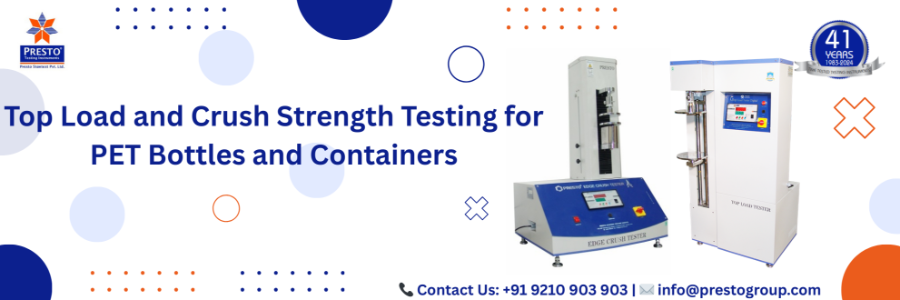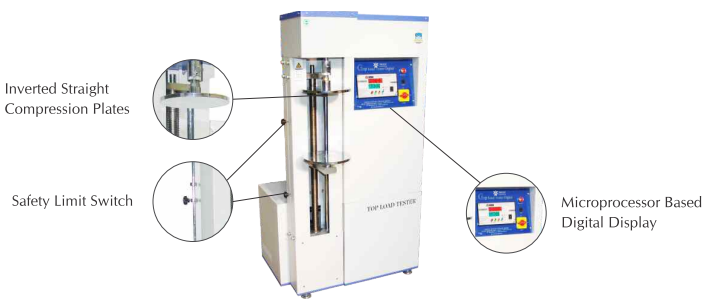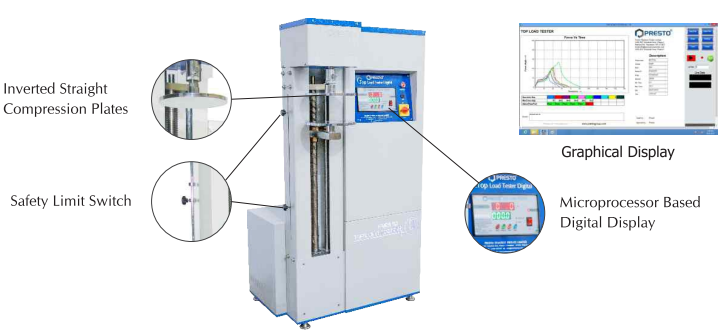

PET (Polyethylene Terephthalate) bottles and plastic containers have become ubiquitous across industries such as food & beverage, pharmaceuticals, personal care, and household chemicals. Lightweight, transparent, and cost-effective, these containers offer several advantages. However, with increasing concerns around sustainability and material optimization, manufacturers are under pressure to reduce plastic usage without compromising structural integrity.
This is where Top Load and Crush Strength Testing becomes critical. These tests determine the mechanical robustness of PET containers, ensuring they can withstand the physical stresses of stacking, transportation, and storage.
In this blog, we will explore the importance, process, and equipment used in Top Load and Crush Resistance Testing, with a focus on both digital and manual top load testers as well as crush resistance testers.
The structural strength of PET bottles directly affects product safety, shelf life, and user experience. A container that buckles or deforms under pressure can lead to:
With the push towards lightweighting (reducing material usage), the margin for error becomes even smaller. Top load and crush testing helps packaging engineers ensure bottles remain strong enough even with reduced wall thickness.
Top load testing measures the compressive strength of a container when force is applied vertically (from the top). The goal is to determine how much weight or load a PET bottle can withstand before it begins to buckle, deform, or collapse.
Crush resistance testing, often used interchangeably with top load testing, focuses on the ability of a container to resist external pressure or crushing forces, not only from the top but also from the sides in certain test variants.
It is essential for:
There are two main types of equipment used for top load testing: digital top load testers and manual top load testers. Both have their own advantages based on the application and scale of testing.
A digital top load tester provides precise and automated compression testing. It uses sensors and digital displays to record real-time data on applied force, deformation, and maximum load.

Features:
Advantages:
Use Case:
A beverage company looking to develop lightweight bottles while maintaining stacking strength would benefit from a digital top load tester to compare different bottle designs with detailed metrics.
A manual top load tester requires the operator to manually apply force, typically via a rotating wheel or lever system, while reading values on a mechanical or digital gauge.

Features:
Advantages:
Use Case:
A small packaging unit that needs basic quality checks on each batch of PET bottles can use a manual tester to ensure minimum load resistance is met.
A crush resistance tester is a specialized device used to apply both vertical and lateral pressure to assess a container’s ability to resist deformation from crushing forces.
Key Features:
Common Applications:
Several international standards govern top load and crush testing for PET containers, including:
These standards guide parameters like test speed, sample size, environmental conditions, and result interpretation to ensure uniformity and repeatability.
Material Grade:
Wall Thickness:
Design and Geometry:
Blow Molding Quality:
Closure System:
Using dedicated PET bottle testers like top load or crush resistance machines brings several advantages:
Often Industries want the real simulation of compression bearing capacity of a sample. Hence, they prefer capped bottle testing and many times filled capped bottle testing with the Compression testing machine.
Hence, If want to simulate actual stacking strength then the capped testing is perfect. Otherwise, if user wants to check the wall rigidity of the sample then uncapped testing is preferable.
Top Load and Crush Strength Testing is very important for companies that use PET bottles and containers. As more people want eco friendly and light packaging strong testing is now more important than ever.
No matter if you run a small unit or a big bottling plant using a good top load tester and a crush resistance tester helps you make sure your bottles are strong and safe to use.
When you understand how pressure and crush strength work and choose the right testing tools you can save money improve your packaging and keep your customers happy in a busy market.
Looking to buy a top load tester or a crush resistance tester for PET bottles at the best price in India?
At Presto Group, we offer high-precision digital and manual testers engineered for quality, accuracy, and long-term durability. Whether you're in the beverage, pharma, or packaging industry, our machines ensure your PET bottles meet top load and crush resistance standards with ease.
Call us now at +91 9210 903 903
Email: info@prestogroup.com
Request a free demo or get a quote today!
Ensure your PET bottles never fail under pressure—Test with Presto!
Connect with us for your business enquiries. Generally, we respond within one or two working days.